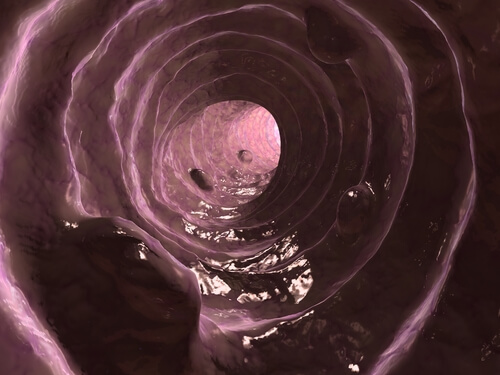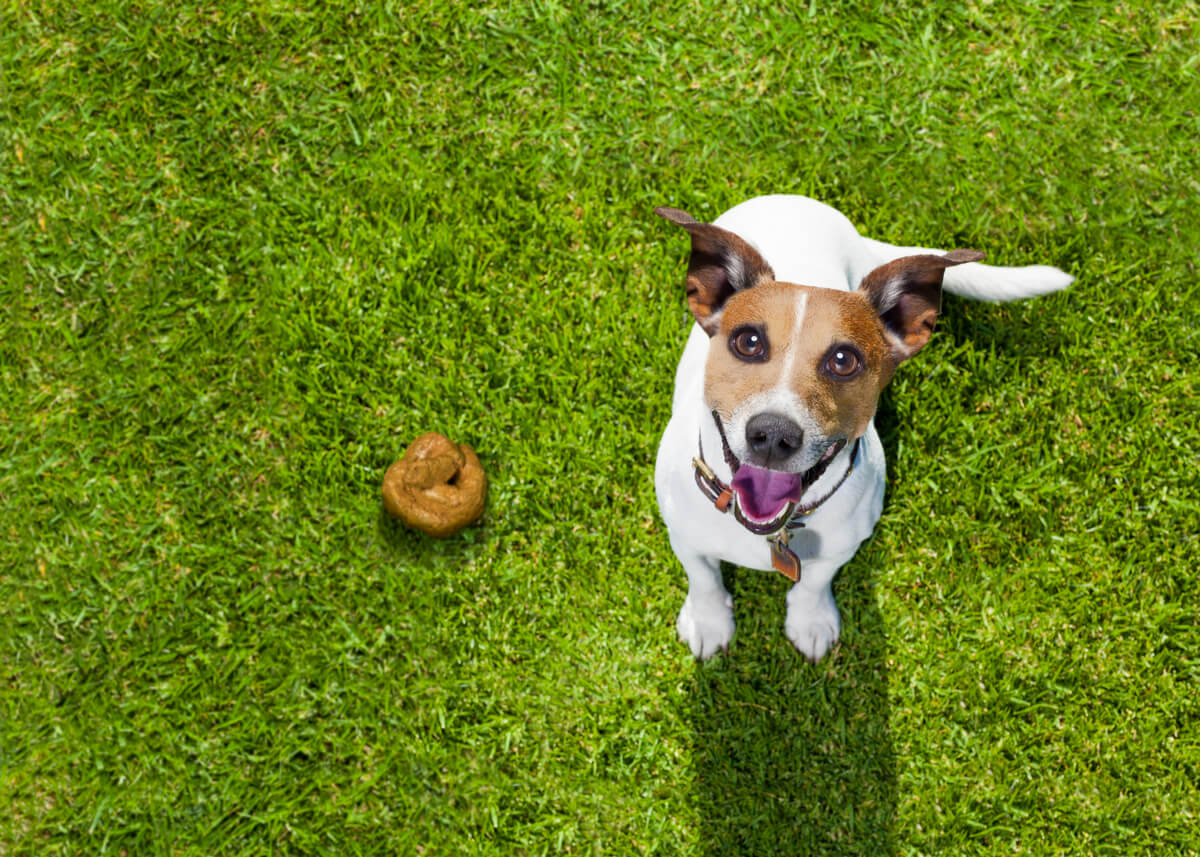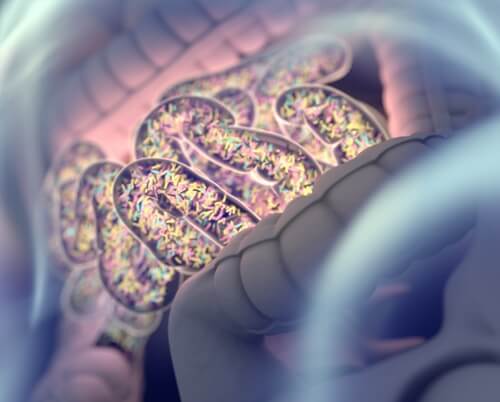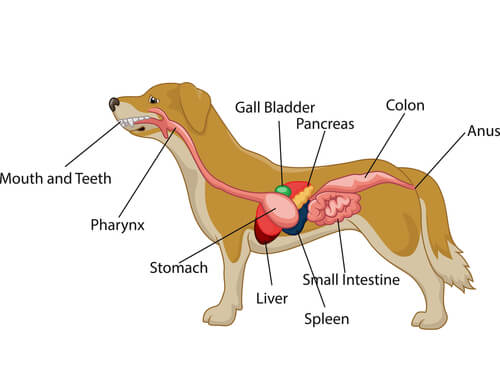Mucus in Dog Feces: Causes and Treatment

First of all, it should be noted that the mucus in dog feces is a necessary element. In fact, it is perfectly healthy for stools to often have mucus in them. So, there’s nothing to worry about if you see a small amount. It actually helps to lubricate the dog’s stools and helps it to do its “number twos” without having to exert too much effort.
However, in some cases, this mucus is present in larger amounts than normal. And, you should be even more concerned if, for example, this is accompanied by changes in consistency, blood, and abdominal pain in the dog. Here we show you when mucous stools are worrying and how to act.
Mucus is a substance secreted by the intestinal mucosa – similar to that produced by the respiratory epithelium- whose function is to keep the lining of the colon lubricated and moist.
What are normal dog stools like?
In order to discover excess mucus in dog feces, you first need to know what normal stools from a healthy dog look like. We’ll show you in the following list:
- Color: It should be chocolate brown. A red hue indicates intestinal bleeding, while a black one is evidence of bleeding in the stomach. Green is also sporadically normal and is usually due to the dog having eaten some grass.
- Shape: Cylindrical and elongated. If the dog defecates in the form of “pellets” it’s possible that it’s dehydrated or has constipation.
- Consistency: Similar to plasticine, i.e. solid but moldable. Stools that are impossible to pick up and fall apart just by touching them indicate diarrhea.
- Composition: Smooth and not grainy. The presence of white spots on the surface may indicate that the dog has intestinal parasites. However, this last value varies greatly with the diet.
As you can see, a normal stool isn’t characterized by the presence of a very obvious film of mucus covering it. It’s natural for them to be somewhat lubricated, but never excessively so. See your vet if you notice any imbalance in your dog’s stools.

What causes excess mucus in dog stools?
It’s important to note that the presence of an excessive amount of mucus in dog stools can be an indication of disease. As we’ve said, the finding is especially relevant if it’s accompanied by blood or a radical change in the consistency of your dog’s stools.
In these cases, the recommendation is to seek immediate veterinary medical attention. Your veterinarian will be better able to identify the underlying cause and recommend an appropriate course of treatment. Here are some common causes of excess mucus in dog feces.
Intestinal infections
A common cause is that pathogens – be they bacteria, viruses, and fungi – infect the canine gastrointestinal (GI) system. Bacterial overgrowth (e.g., Salmonella) can occur inducing an imbalance in the canine intestinal microbiome.
Most dogs will also develop diarrhea, vomiting, loss of appetite, or other symptoms. Supportive care and medications that address the infection will be needed. Also, a probiotic supplement may help if prescribed by a veterinarian.
Antibiotics are useful, but only if the infection is bacterial. In viral the only option in many cases is supportive treatment.
Parasites
Trichuriasis, giardiasis, tapeworms and other intestinal parasites can cause mucus in dog feces. These pathogens take up residence in the walls of your dog’s intestine, feeding on its blood or the nutrients from its food. A fecal examination can identify the type of parasite present and an appropriate dewormer will solve this problem.
The presence of eggs or body segments (white dots) in the dog’s stools confirms the diagnosis.

Foreign body ingestion
When a dog eats something unusual, it can disrupt the gastrointestinal tract and cause increased mucus production in the stools. Mild cases resolve over time. More severe cases, accompanied by vomiting and diarrhea, may require supportive care, antibiotics, fluid therapy, and sometimes even surgery to remove the foreign material.
Change in diet or adverse reaction to food
A sudden change in diet can cause mucus in dogs’ stools. In these cases, it’s recommended to return to the original diet. To make the dietary change, offer progressively increasing amounts of the new food mixed with the old food. This will usually solve the problem.
If the dog’s symptoms persist, a food allergy or intolerance may be to blame. In these cases, it may be necessary to switch to a hypoallergenic diet prescribed by a veterinarian.
Irritable bowel syndrome
Irritable bowel syndrome (IBS) is a condition in which part of the dog’s digestive tract becomes constantly inflamed. This damages the tissues of the segments involved, making it very difficult to absorb nutrients and minerals. It’s chronic and doesn’t always have a definite cure.
In this condition, stress is believed to be a major factor in these outbreaks. Treatment involves stress relief, dietary changes, and medications – for example, sulfasalazine – that decrease the severity of the dog’s symptoms.
Cancer
Cancer anywhere in the gastrointestinal tract, tumors, and polyps – such as rectal polyps – can cause mucus in the stools. Treatment for these conditions usually includes surgery, chemotherapy, radiation, or palliative therapy. The prognosis depends greatly on the nature of the tumor (whether it’s neoplastic or benign).
Other inflammatory disorders
Disorders other than irritable bowel syndrome can cause mucus in the stools, usually accompanied by vomiting or diarrhea. Treatment with immunosuppressive medications and dietary changes will often reduce a dog’s symptoms.
Immunosuppressive drugs are a double-edged sword. By depressing the dog’s immune system, they reduce inflammation, but also their effectiveness in stopping infections.
Hemorrhagic gastroenteritis
When a dog’s stool contains a lot of blood and mucus (often described as raspberry jam), hemorrhagic gastroenteritis may be the culprit. Treatment includes supportive care, anti-nausea medications, fluid therapy and antibiotics.
General treatments for mucus in dog stools
Although we’ve listed some drugs and medications in each case, we find it helpful to summarize all of the effective treatments to prevent excessive mucus in your dog’s stools. We’ll tell you about them in the following list:
- Antibiotics: These should only be applied if the cause of the mucus has been confirmed as a bacterial infection, such as Salmonella.
- Anthelmintics: These are the most common drugs used to treat infections caused by intestinal endoparasites. They’re fast-acting and very effective.
- Surgery: Surgery may be necessary if an impaction has occurred, if the dog has eaten something indigestible, if there’s a tumor, or if the ball of intestinal parasites is too large.
- Changes in diet: This is the most common “treatment”, as, in most cases, the presence of mucus in the dog’s stools is the result of indigestion or food intolerance.
- Immunosuppressants: As we’ve said, these drugs help to reduce the inflammation of the gastrointestinal tract if the cause is immune-mediated. Unfortunately, they can’t be abused.
At this point, it’s necessary to emphasize that only a professional veterinarian will be able to diagnose the condition that afflicts your canine. You can help your dog with probiotics and preventative dietary changes at home, but a visit to the vet is almost always an urgent need.

As you can see, there are many reasons why mucus appears in dog stools. Most of them are anecdotal and mild, but others require extensive long-term treatment. Only the veterinarian can tell you what the situation is with your dog.
All cited sources were thoroughly reviewed by our team to ensure their quality, reliability, currency, and validity. The bibliography of this article was considered reliable and of academic or scientific accuracy.
- Verlinden, A., Hesta, M., Millet, S., & Janssens, G. P. J. (2006). Food allergy in dogs and cats: a review. Critical reviews in food science and nutrition, 46(3), 259-273.
- Glass, G. J., & Slomiany, B. L. (1977). Derangements of biosynthesis, production and secretion of mucus in gastrointestinal injury and disease. In Mucus in health and disease (pp. 311-347). Springer, Boston, MA.
- Marks, S. L., & Kather, E. J. (2003). Bacterial-associated diarrhea in the dog: a critical appraisal. Veterinary Clinics: Small Animal Practice, 33(5), 1029-1060.
- Tanimoto, M. A., Torres-Villalobos, G., Fujita, R., Santillan-Doherty, P., Albores-Saavedra, J., Gutierrez, G., … & Valdovinos, M. A. (2010). Endoscopic submucosal dissection in dogs in a World Gastroenterology Organisation training center. World Journal of Gastroenterology: WJG, 16(14), 1759.
- Gue, M., Peeters, T., Depoortere, I., Vantrappen, G., & Bueno, L. (1989). Stress-induced changes in gastric emptying, postprandial motility, and plasma gut hormone levels in dogs. Gastroenterology, 97(5), 1101-1107.
